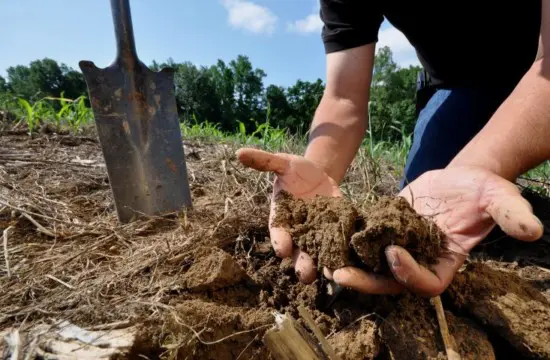Soil is a cornerstone of life on Earth, providing the foundation for agriculture, biodiversity, and climate regulation. However, soil erosion and degradation pose significant challenges that require immediate attention.
Here, we will delve into the importance of soil conservation, the methods used to preserve soil health, and the challenges we face in implementing effective soil conservation practices. Read on to learn why soil preservation is vital not just for farmers but for the planet as a whole.
What is Soil Conservation?
Soil conservation refers to all the methods and practices that protect soil from degradation and erosion.
Soil erosion is a significant issue caused by natural and human factors. Soil erosion can lead to nutrient depletion and loss of organic matter essential for plant growth. Sediment from eroded soil can also cause water pollution and damage infrastructure.
Soil conservation efforts aim to preserve soil fertility and productivity and continue to play a significant role in sustainable farming, food security, and protecting the environment.
What’s the Importance of Soil Conservation Efforts for Agriculture and the Environment?
Soil conservation measures like crop rotation, reducing tillage, and cover cropping help safeguard the soil’s nutrients and organic matter, ensuring its long-term fertility and productivity and setting the stage for sustainable agriculture.
However, the battle for soil health doesn’t end with fertility alone. Another pressing concern is soil erosion, which is particularly rampant in regions with steep slopes or intense rainfall. Conservation techniques like terracing, contour farming, and planting windbreaks provide effective countermeasures that halt the soil from being washed or blown away.
Beyond agriculture, soil conservation has a profound impact on biodiversity as well. A healthy soil ecosystem supports numerous life forms, ranging from microorganisms and insects to larger animals. We can also contribute to a more diverse natural world by maintaining soil health through conservation efforts.
What is Soil Erosion?
Soil erosion refers to the detachment and movement of soil particles by natural forces such as water, wind, ice, and gravity. Erosion is a natural process that occurs over long periods; however, human activities such as land clearing, agriculture, and construction can accelerate it.
During erosion, the top layer of soil is typically the first affected layer. The top layer is rich in organic matter and nutrients, making it essential for plant growth and productivity. Once lost through erosion, it can lead to reduced soil fertility, decreased agricultural productivity, and increased soil runoff and sedimentation in rivers and other water sources.
What are 3 Types of Soil Conservation Methods?
Soil conservation techniques can fall into three main types: physical, biological, and chemical. Each offers a unique approach to maintaining and enhancing soil health but varies in their methods, sustainability, and environmental impact.
Physical Soil Conservation Methods
Physical soil conservation methods focus on altering the soil’s physical structure to reduce erosion and enhance its health. Techniques such as contour farming adapt the soil structure to the landscape, reducing the speed of water flow and limiting erosion.
Terracing, another method, involves shaping the land into a series of steps to control water runoff and soil erosion. Windbreaks and shelterbelts are tree lines planted to block wind, which can otherwise blow away valuable topsoil.
These physical methods often require a significant upfront investment in labor and infrastructure. However, they provide enduring benefits by significantly improving soil stability and fertility once established.
Biological Soil Conservation Methods
Biological soil conservation employs living organisms to enhance soil health. For instance, crop rotation involves alternating different types of crops in a given area, which helps to prevent the depletion of certain nutrients in the soil.
Cover cropping involves planting certain crops that protect the soil from erosion and improve its structure. Agroforestry combines trees, crops, and livestock to create a system that enhances soil fertility and water retention.
Biological methods are generally more sustainable as they harmonize with natural processes. They do not rely on external inputs like chemical fertilizers, making them eco-friendly and cost-effective in the long run.
Chemical Soil Conservation Methods
Chemical methods focus on enhancing soil health through the use of additives. Fertilizers commonly replace lost nutrients and improve soil fertility.
Organic amendments like compost can also enrich the soil, while soil testing and analysis assist in the precise application of these additives, ensuring they meet the soil’s specific needs.
How Do You Choose the Best Soil Conservation Method?
The best soil conservation method for your crops will depend on a variety of factors, including the specific soil and climatic conditions, the land use, and the conservation goals. Here are some steps to consider when choosing the best soil conservation method:
- Assess the site: Evaluate the site’s soil type, slope, rainfall, and land use to determine the most appropriate conservation method. Some methods may be better for steep slopes, while others are more suitable for flat terrain.
- Identify the conservation goals: Determine the conservation goals, such as reducing soil erosion, increasing soil organic matter, or improving water quality. Different conservation methods impact these goals in different ways.
- Evaluate the benefits and costs: Look at the benefits and costs of each method, including the initial and ongoing costs, labor requirements, and long-term benefits for soil health and productivity.
- Consider the potential trade-offs: Understand that each conservation method comes with potential trade-offs, such as reduced crop yields or additional labor requirements.
- Consult with experts: Seek advice from soil conservation experts, extension agents, or other farmers with experience implementing soil conservation practices. They can provide valuable insights into your specific situation.
What are the Benefits of Soil Conservation?
Soil conservation offers many advantages that stretch from the micro-level of soil particles to the macro-level of global ecosystems. These benefits touch upon various facets of life, including agriculture, the environment, and even the economy.
Improved Soil Health
Using soil conservation techniques like cover cropping, crop rotation, and reduced tillage leads to healthier soil. These practices enhance soil fertility and improve its structure and water-holding capacity. The result is a more resilient soil that can better support plant growth, leading to increased crop yields and less susceptibility to erosion.
Enhanced Water Quality
The health of our waterways directly ties into soil management. Soil conservation practices reduce the runoff of sediment, nutrients, and pollutants into water sources. This results in improved water quality that benefits aquatic life and makes water safer for human consumption.
Reduced Greenhouse Gas Emissions
Some soil conservation methods, such as no-till farming and agroforestry, can act as carbon sinks, pulling carbon dioxide from the atmosphere and storing it in the soil.
Increased Biodiversity
By creating a more stable and nutrient-rich environment, soil conservation practices can aid biodiversity. These techniques provide habitats conducive to the growth of various lifeforms, from beneficial insects and microorganisms to larger wildlife.
Improved Economic Sustainability
Economically, soil conservation is a win-win. These practices can reduce the need for external inputs like fertilizers and irrigation, lowering the operational costs for farmers by bolstering soil health. Healthier soil also typically means higher crop yields, which translates to increased revenue, ensuring the long-term economic sustainability of farming operations.
What are the Challenges of Soil Conservation?
While it offers numerous benefits, soil conservation has its own set of challenges that can hinder its widespread implementation.
One of the primary obstacles is the lack of knowledge or awareness among landowners. Many hesitate to invest in these practices without a solid understanding of the long-term advantages of soil conservation.
Economic barriers further exacerbated the problem. For example, the high upfront costs associated with methods like terracing or constructing windbreaks could deter risk-averse individuals or those operating on thin margins.
Another pressing issue is land use pressure, fueled by a growing global population and the increasing demand for agricultural land, often leading to the conversion of marginal lands and natural habitats that are more susceptible to erosion and degradation.
Addressing these challenges demands a multi-pronged approach that includes educational initiatives to raise awareness among farmers, policy reforms to incentivize sustainable farming practices, and ongoing research to innovate more effective and cost-efficient methods.
Final Thoughts on Soil Conservation Efforts
Soil conservation is a multifaceted issue that intertwines with various aspects of life—from agriculture and biodiversity to climate change and economic sustainability. While we still face many challenges, from lack of awareness to policy barriers, successful soil conservation provides us with plenty of benefits.
If you would like to learn more about how you can play your part as a farmer or landowner, consider contacting one of our specialists or visiting a retailer for more information.


